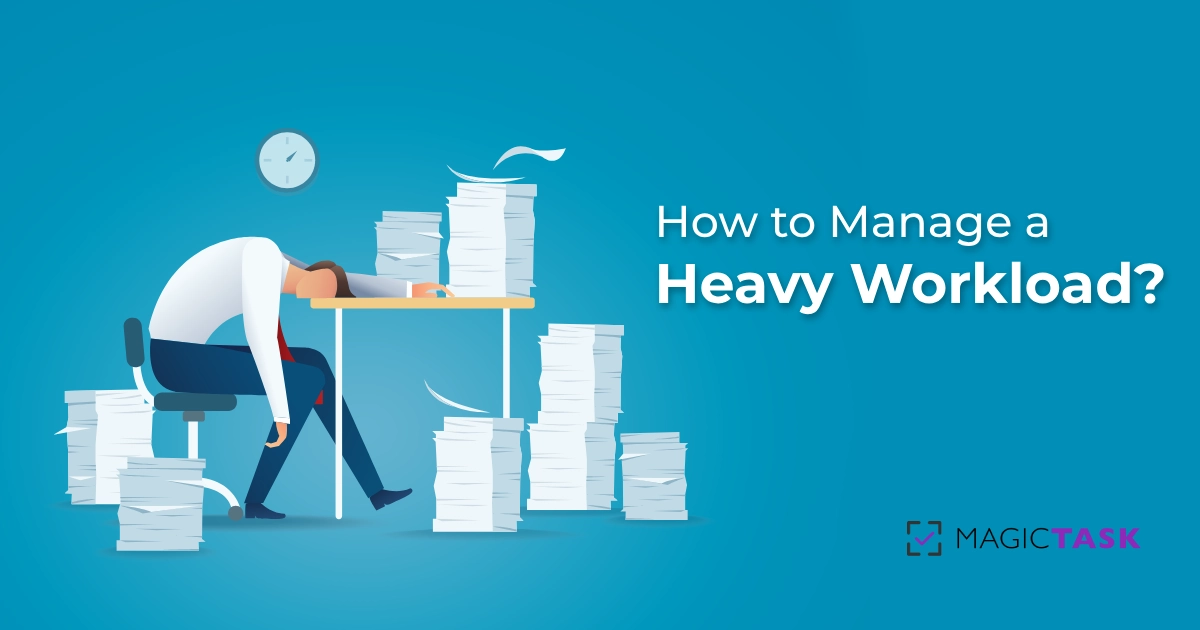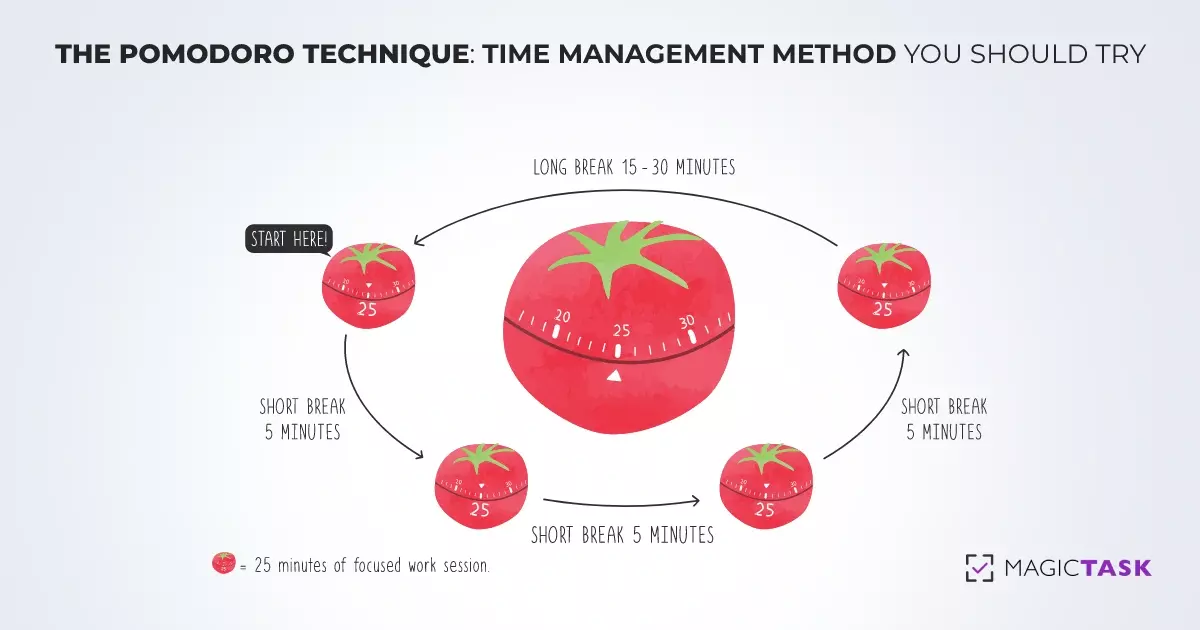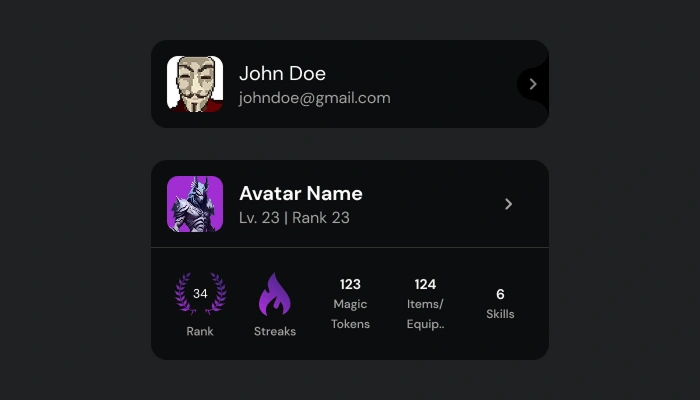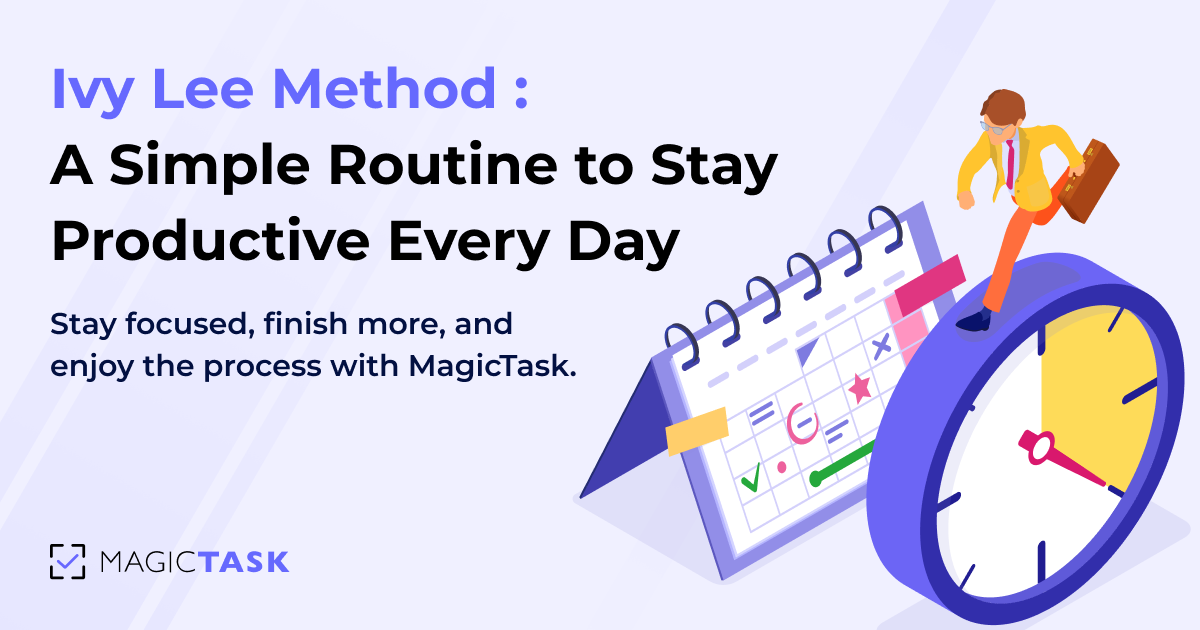How to Manage a Heavy Workload While Staying Focused and Motivated

Managing a heavy workload can feel like a full-time job in itself. Between back-to-back meetings, constant emails, and a growing list of priorities, it’s easy to lose focus, and even easier to lose motivation.
But even in the busiest seasons, it’s possible to take control of your time, your energy, and how you tackle each day, rather than just scrambling to keep up.
In this article, you’ll find practical strategies to help you manage a demanding workload, stay organized under pressure, and keep your motivation steady, even when the pace doesn’t slow down.
Let's start!
Why a Heavy Workload Leads to Stress and Burnout
But before we dive into our tested techniques, let’s first examine why an endless to-do list and constant distractions drain your energy and cause burnout.
1. Mental Overload Slows You Down
When your work plate is overflowing, your brain struggles to keep up. Cognitive overload makes it challenging to prioritize tasks, which often leads to procrastination.
Research shows that over half of our focused periods are cut short by distractions, 57%.
Extended work sessions frequently derail even in collaborative environments due to constant disruptions. And while you might eventually pick your work back up the same day, you've already bounced between multiple unrelated tasks by then.

This frequent task-switching silently erodes your focus, undermining your productivity.
From a psychological standpoint, constant distractions overload the part of your brain that handles decision-making and prioritizing.
When your attention is constantly being pulled in different directions, even simple tasks can suddenly seem overwhelming, and that natural dopamine burst, your brain’s reward for a job well done, is significantly diminished.
Without a clear, uninterrupted focus, productivity slows, and you end up postponing decisions simply because your mind is overburdened.
2. Focus Slips, and Progress Stalls
When focus slips, it’s not just your output that suffers; it’s your momentum.
You start a task, get interrupted, try to pick it back up, and before long, you’re stuck in a loop of half-finished work. That feeling of always being busy but never actually finishing anything creates frustration and fatigue.
Even brief distractions can steal large chunks of your day. One small interruption can cost you up to 30 minutes of productive time. Multiply that across a workday, and it's easy to see how progress slows to a crawl, not because you're not working, but because you're never fully locked in.
3. Lack of Progress Feels Demotivating
When your to-do list is overflowing, it’s easy to feel like you’re working nonstop but not actually getting anywhere.
Take a sales manager, for example, juggling meetings, fine-tuning strategies, chasing leads, and handling reports. It’s a nonstop effort.
But without clear signs of progress, like steady revenue growth or team milestones, all that work starts to feel invisible.
And when progress feels invisible, motivation takes a hit. Even if you're chasing small wins, it’s hard to stay driven when nothing feels like it’s adding up.
4. Productivity Tools Can Feel Overwhelming
The tools designed to help you stay productive can sometimes end up doing the opposite.
With endless settings to adjust, features to learn, and dashboards to customize, you might find yourself spending more time setting things up than actually getting things done.
Instead of simplifying your workflow, these tools can become just another task on your list. And when the systems meant to save time start eating it up, the result is more frustration, not more focus.
💡 Key takeaway: You don’t just need to work harder—you need to work smarter.
Now that we’ve unpacked the problem, let’s look at what you can actually do about it.
Proven Techniques to Manage a Heavy Workload
You don’t need more hours in the day — you just need the right approach.
Here are some tried-and-true methods to help you stay sharp, organized, and on top of what matters most.
1. The Eisenhower Matrix: Prioritize Tasks Effectively
When your task list starts looking more like a scroll, it’s easy to treat everything like it’s equally urgent.
But not all of them need your attention.
The Eisenhower Matrix is a simple task prioritization framework that helps you sort tasks by urgency and importance so you can focus on what matters most, not just what shouts the loudest.
Here’s how it works:
- Urgent & Important: These are critical, deadline-driven tasks that have a real impact. They deserve your immediate attention.
- Important, Not Urgent: Strategic work, long-term planning, and relationship-building fall here. They don’t scream for attention, but they’re essential.
- Urgent, Not Important: These tasks might feel pressing, but don’t require your expertise. Pass them on to someone with a better grasp of the task when possible.
- Neither Urgent nor Important: If a task isn’t time-sensitive or valuable, it’s clutter. Clear it out to reclaim your focus.

Let’s say you start your Monday with this chaotic list:
- Finalize the client proposal due today
- Respond to Slack messages
- Plan next quarter’s marketing strategy
- Review performance reports
- Attend a meeting that could’ve been an email
- Book a dentist appointment
- Organize your Google Drive
- Handle a last-minute request from your boss
- Schedule 1:1s with your team
- Scroll LinkedIn (again)
Now, let’s sort those into the matrix:
| Category | Urgent | Not Urgent |
|---|---|---|
| Important |
|
|
| Not Important |
|
|
The Eisenhower Matrix helps you get out of reaction mode. Instead of jumping from one “urgent” task to the next, you’ll lead your day with intention. And giving high-impact work the time it deserves.
Quick tip: Start your morning by sorting your top priorities into each category. You’ll be surprised how quickly clarity follows.
2. The Pomodoro Technique: Stay Focused with Timed Work Sessions
Are you staring at your screen, half-working, half-scrolling, and fully stressed?
The Pomodoro technique can help.
It’s a simple time management method that uses short bursts of focused work followed by regular breaks to keep your mind fresh and your motivation high.
Here’s how it works:
- Pick a task you want to tackle.
- Set a timer for 25 minutes (this is one “Pomodoro”).
- Work on that task and only that task until the timer rings.
- Take a 5-minute break—walk, stretch, breathe, and don’t doom scroll.
- After 4 Pomodoros, take a longer break (15–30 minutes).
This cycle helps maintain your concentration and prevents burnout over the long haul.

For example, if you're in the middle of preparing a report, you set your timer for 25 minutes and work solely on the report, resisting the urge to check emails or browse social media.
Once your session ends, you step away, perhaps stretching or grabbing a coffee, and then return to the task with renewed focus.
When you consistently apply this method, you transform a chaotic workday into a series of manageable sprints, each building on the last and moving you steadily toward your larger goals.
3. Task Batching: Minimize Task Switching
There's another strategy to maximize your productivity even further, known as Task Batching. It is about giving your brain permission to settle down and focus on one type of task at a time.
Instead of letting your to-do list turn into a constant game of "what’s next?"—which forces your mind to switch gears repeatedly—you group similar tasks into dedicated time blocks.
Here’s the idea in plain terms: if you block off an hour to answer emails, you're not constantly tearing your attention away when another task nudges for attention. That way, your mind stays locked in, and you breeze through that batch with fewer disruptions.

Completing a batch of similar tasks gives you a continuous, satisfying sense of accomplishment that propels you to the next challenge.
As Dr. Sahar Yousef, a cognitive neuroscientist at UC Berkeley, says, “The human brain works best when focusing on one thing at a time. We have a certain amount of cognitive capacity and a certain amount of attention.”
It reminds us that our mental energy is precious and finite. If we constantly scatter our focus, we risk diluting our efforts on tasks that do not matter. This brings us to another powerful strategy for managing our workload.
4. The 80/20 Rule (Pareto Principle): Focus on High-Impact Work
The 80/20 Rule, also known as the Pareto Principle, is built on a profound idea: 80% of your results come from just 20% of your efforts.
Applying this to your work involves identifying the few critical tasks that will have the most significant impact.
Think about everything on your to-do list. Many of those items might feel important, but not all of them will drive your success in the same way.

Here’s how you can apply the 80/20 Rule:
Step #1: Review Your Tasks:
Look at your to-do list. Which tasks will directly impact your goals? Which ones feel busy but aren’t moving the needle? Be honest about the value each task brings.
Step #2: Classify Tasks by Impact
Once you've identified your high-impact tasks, prioritize them. These are the ones that deserve the most attention and effort.
Step #3: Focus on High-Impact Activities
Give your most important tasks your full focus. Avoid getting distracted by tasks that might be easy but don’t contribute much to your larger objectives.
Step #4: Delegate or Eliminate Low-Impact Tasks
Delegate or eliminate tasks that don’t require your direct involvement. Your time is valuable, and low-impact tasks should not monopolize it.
Step #5: Measure and Adjust
Review your progress regularly. Is your focus on high-impact tasks yielding the results you want? If not, adjust and refine your approach.
The beauty of the 80/20 Rule is its simplicity. Instead of focusing on doing more, it encourages doing less, but better. But even with fewer, more impactful tasks, time is still your most precious resource.
That brings us to the following proven technique.
5. Time Blocking: Schedule Your Day for Maximum Productivity
Time blocking is one of the most effective techniques for managing a heavy workload.
It’s exactly what it sounds like—dedicating specific blocks of time to focused work. Instead of trying to fit tasks into your day as they come, you create a schedule in advance that ensures your most important tasks get the attention they deserve.
With clear boundaries for when and how long you’ll work on each task, you eliminate the mental load of deciding what to do next. This approach also encourages deep work, which leads to higher-quality results in less time.
How to Time Block?
1. Assess Your Tasks
Before blocking time, assess the tasks you need to accomplish. Break them down by priority, urgency, and complexity. Recognizing how much focus and energy each task requires will help you allocate appropriate time slots.
2. Create Time Blocks
Start by allocating time for your most important and demanding tasks. These are the activities that need uninterrupted focus.
For example:
- 9:00 AM - 11:00 AM: Write the project proposal
- 11:00 AM - 12:00 PM: Respond to emails
- 12:00 PM - 1:00 PM: Lunch break
- 1:00 PM - 3:00 PM: Research new business trends
- 3:00 PM - 4:00 PM: Prepare client presentation
3. Be Specific with Your Blocks
It’s tempting just to say, “Work on the project proposal for two hours,” but the more specific you are, the better.
Define what you will accomplish during each block. For example, “Complete introduction and first draft of the proposal” gives you a concrete goal.
4. Schedule Breaks
It’s crucial to schedule breaks in between time blocks to avoid burnout. A 5-10 minute break every hour is a good practice.
The Pomodoro Technique is a successful method that you can integrate with time blocking.
5. Use a Calendar or Planner
Whether it’s a physical planner, Google Calendar, or a task management app, find a tool that works to organize your time. A clear view of your day will keep you accountable and help you stay on track.
6. Stick to Your Schedule
The key to time blocking is commitment. Try to stick to the blocks you’ve set, even if you get distracted. If something urgent pops up, move it to the next available time slot.
If you’re feeling scattered by your heavy workload, try time blocking. It might just be what you need to streamline your work and boost productivity. However, having the proper technique is only part of the equation. The tools you use matter, too.
How MagicTask Helps You Manage Your Workload and Stay Motivated
If the proven techniques mentioned above help you organize your workload, MagicTask helps you stay on top of it.
Here's how it turns structure into real momentum.
1. Prioritize Work with Task Sizing
One of MagicTask’s most powerful features is its simple "Task Sizing" system. Every time you create a new task, you assign it a size — S, M, L, or XL — based on its complexity and how much time it will take.

This helps you quickly sort through your workload and spot what needs your attention first. Instead of staring at a messy to-do list, you get a clear, structured view of what’s ahead. When you're ready to focus, just drag your top priority into the "My Focus" section and lock in.
Each completed task moves you forward in a visible way. That sense of progress, even in small steps, creates momentum, and that momentum is what keeps you motivated through busy days.
2. Stay Focused on One Task at a Time
Ever spent more time setting up your digital workspace than actually using it? Tools like Notion or Asana are packed with features, but all that flexibility can turn into a distraction. Instead of helping you focus, you end up lost in dashboards and settings.
MagicTask takes a different approach. It’s built to keep you locked in on what really matters — the task in front of you. No clutter, no endless tweaking. Just one clean, focused space where you can do your work without the usual noise.

When you open MagicTask, you’re not staring at a maze of tabs, charts, or distractions. You see, the one thing you’ve chosen to work on — and that’s it.
This simplicity gives your brain room to focus. No decisions to make about what to tackle next, no wasted energy jumping between priorities. You just get to work.
By cutting out the extras, MagicTask helps you get into a flow state faster and stay there longer. That’s the kind of focus most tools promise, but few actually deliver.
3. See Your Progress and Stay Motivated
Now that you're focused on one task at a time, the next step is seeing that focus pay off.
Let’s say you’re compiling an annual performance report. As you work through gathering data, analyzing trends, and drafting insights, each task you complete earns you points. With MagicTask, these points accumulate, helping you level up and unlock new themes and animations.
Meanwhile, a dynamic leaderboard tracks your progress, not just as a personal record but also in comparison to your colleagues. This visual display of achievement and healthy competition reinforces every win, driving you to tackle the next section of the report with renewed energy.
In short, when every small task becomes a measurable victory, it keeps your motivation and focus sharp.
4. Work Feels Rewarding, Not Draining
With your progress now visible, you can feel the fireworks in your brain, a burst of dopamine celebrating each success.

MagicTask taps into that power by making task completion something you can see and feel. Every finished task rewards you, just like a game would. These rewards don’t just disappear into a scoreboard; they serve as milestones on your journey, giving you a clear sense of progress.
As you level up, you unlock new game-like themes, celebrating your achievements in real time. It's not about distracting you with bells and whistles; it's about creating a system where your hard work is immediately recognized and reinvigorates your drive.
Gamification turns the workday into a collection of small wins. And you already know the power of small wins – they boost your productivity by as much as 28%.
Conclusion
At the end of it all, your goal is to manage a heavy workload with a motivated spirit. With the right system, you can stay productive without sacrificing your motivation.
When you structure your work, minimize distractions, and celebrate every small win, you unlock a sustained energy and focus cycle. These proven techniques pave the way to transform chaos into clarity.
Are you ready to make work engaging instead of exhausting?
Try MagicTask today and experience how an innovative, gamified approach can turn even the busiest day into a series of rewarding wins.




